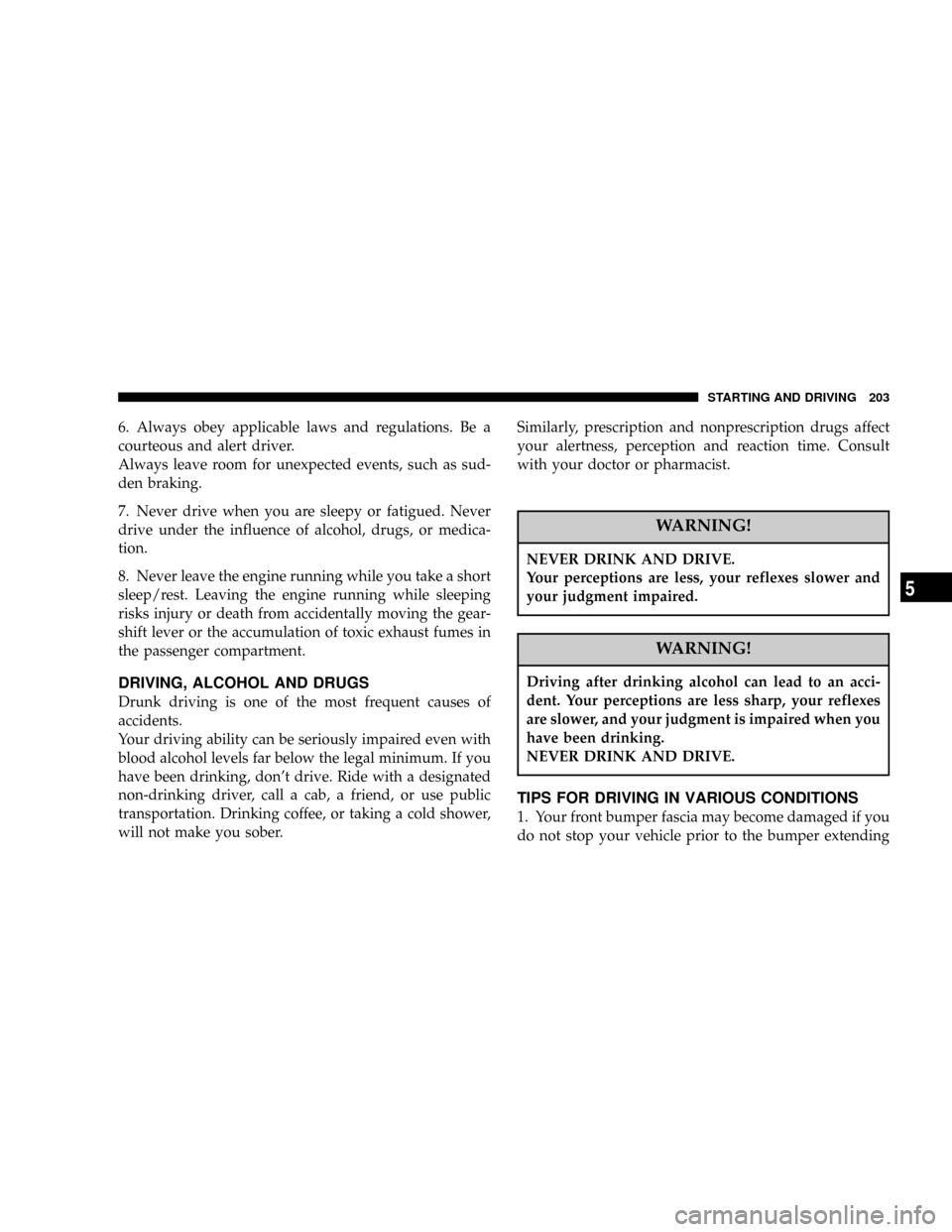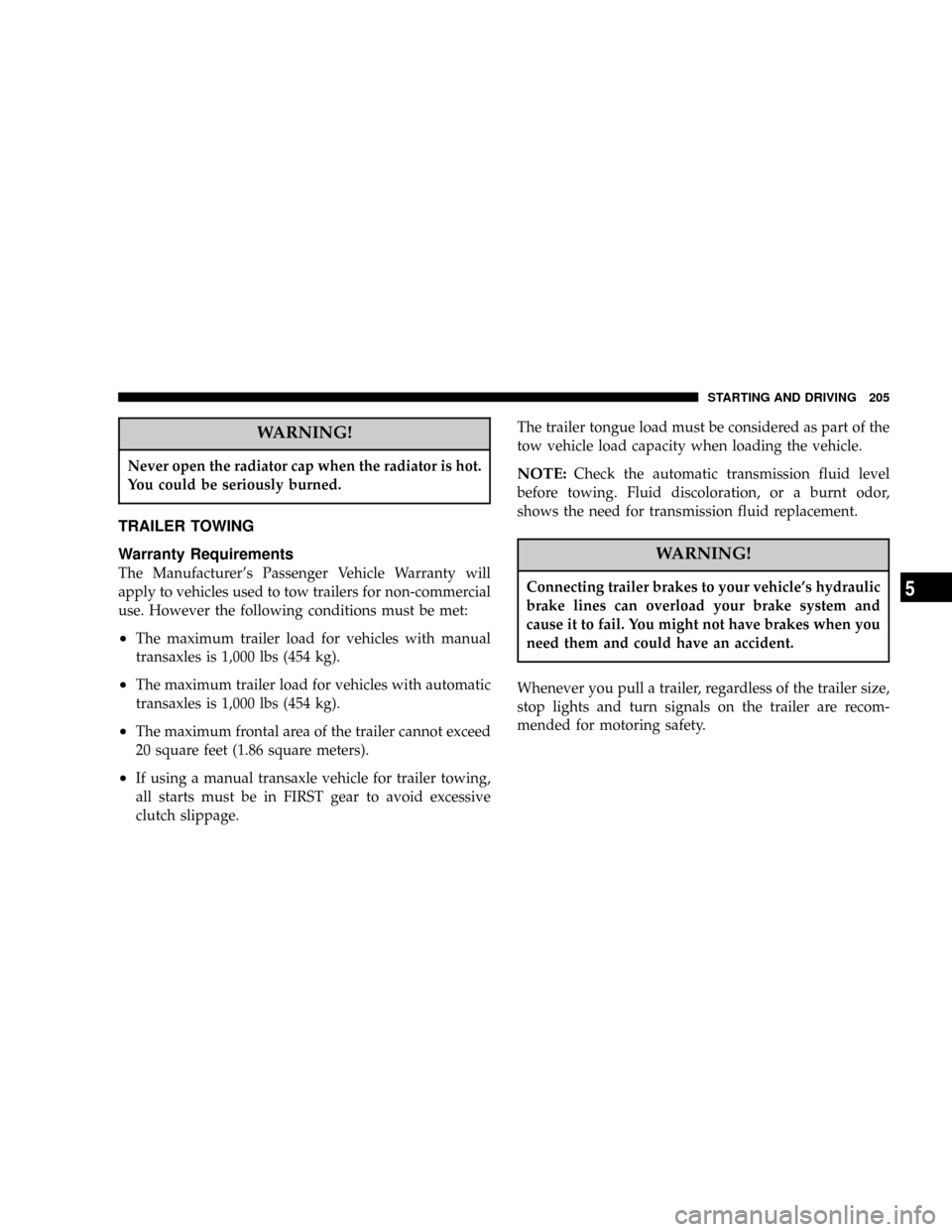DODGE STRATUS COUPE 2005 2.G Owners Manual
Manufacturer: DODGE, Model Year: 2005, Model line: STRATUS COUPE, Model: DODGE STRATUS COUPE 2005 2.GPages: 396
Page 201 of 396

8. Stop driving the vehicle if you think the performance
is noticeably less, or that there is unnecessary engine
miss, or any other engine trouble, such as with the
ignition, etc. If it is impractical to stop driving immedi-
ately, reduce the speed and drive for only a short time.
Have an inspection made by an authorized dealer as
soon as possible.
9. In an unusual event of a severe engine malfunction, a
scorching odor may indicate severe and abnormal cata-
lytic converter overheating. If this occurs, the vehicle
should be stopped in a safe place, the engine shut off and
the vehicle allowed to cool. Once the engine is cool, the
vehicle should immediately be taken to a dealer for
service.
VEHICLE PREPARATION BEFORE DRIVING
Before starting on a trip, perform the following checks to
obtain the greatest possible enjoyment and safety from
your vehicle:
Seat belts and seats
1. Before starting the vehicle, make certain that you and
all your passengers are seated and properly wearing the
seat belts (with children in the rear seat, in appropriate
restraints), and that all doors are locked.
2.
Adjust the driver's seat as far back as possible, while still
maintaining good visibility, and good control of the steering
wheel, brakes, accelerator, and controls. Examine the instru-
ment panel indicators for any possible malfunction.
3. Have the front passenger adjust their seat as far
rearward as possible.
Defrosters
Check operation by selecting the defroster mode and set
the blower switch for high speed operation. You should
be able to feel the air directed against the windshield.
(See ªHeater /Air conditioningº page 238.)
Tires
Examine all tires for excessive tread wear or uneven wear
patterns. Check for stones, nails, glass, or other objects
lodged in the tread. Inspect for tread cuts or sidewall
cracks.
STARTING AND DRIVING 201
5
Page 202 of 396

Check wheel nuts for tightness and tires (including spare
tire) for proper pressure. Maintain specified tire inflation
pressures. Replace tires before they are excessively worn.
Lights
Have someone observe the operation of all exterior lights
while you activate the controls. Check the turn signals
and highbeam indicators on the instrument panel.
Fluid leaks
Check the area under the vehicle after overnight parking
for fuel, water, oil, or other fluid leaks. Make sure all fluid
levels are at the proper levels. Also, if fuel leaks are
detected, the cause should be located and corrected
immediately.
Driver
Do not drive if you are tired or sleepy. Do not drive if you
have been drinking or taking drugs. Unless you are alert
and able to concentrate on your driving, you could have
an accident, resulting in serious or fatal injury to yourself
and others.
SAFE DRIVING TECHNIQUES
Even this vehicle's safety equipment, and your safest
driving, cannot guarantee that you can avoid accident or
injury. However, we recommend that you give extra
attention to the following, to help maximize the safety of
you and your passengers:
1. Drive defensively. Be aware of traffic, road and
weather conditions. Leave adequate stopping distance
for your vehicle.
2. Before changing lanes, check your mirrors and flash
the proper turn-signal light.
3. While driving, watch the behavior of other drivers,
bicyclists and pedestrians.
4. During an emergency stop, switch on the hazard
warning flasher.
5. When leaving the vehicle, set the parking brake and
place the gearshift lever into low gear.
In vehicles with an automatic transaxle, place the selector
lever in the ªPº (PARK) position. Remove the key.
202 STARTING AND DRIVING
Page 203 of 396

6. Always obey applicable laws and regulations. Be a
courteous and alert driver.
Always leave room for unexpected events, such as sud-
den braking.
7. Never drive when you are sleepy or fatigued. Never
drive under the influence of alcohol, drugs, or medica-
tion.
8. Never leave the engine running while you take a short
sleep/rest. Leaving the engine running while sleeping
risks injury or death from accidentally moving the gear-
shift lever or the accumulation of toxic exhaust fumes in
the passenger compartment.
DRIVING, ALCOHOL AND DRUGS
Drunk driving is one of the most frequent causes of
accidents.
Your driving ability can be seriously impaired even with
blood alcohol levels far below the legal minimum. If you
have been drinking, don't drive. Ride with a designated
non-drinking driver, call a cab, a friend, or use public
transportation. Drinking coffee, or taking a cold shower,
will not make you sober.Similarly, prescription and nonprescription drugs affect
your alertness, perception and reaction time. Consult
with your doctor or pharmacist.
WARNING!
NEVER DRINK AND DRIVE.
Your perceptions are less, your reflexes slower and
your judgment impaired.
WARNING!
Driving after drinking alcohol can lead to an acci-
dent. Your perceptions are less sharp, your reflexes
are slower, and your judgment is impaired when you
have been drinking.
NEVER DRINK AND DRIVE.
TIPS FOR DRIVING IN VARIOUS CONDITIONS
1. Your front bumper fascia may become damaged if you
do not stop your vehicle prior to the bumper extending
STARTING AND DRIVING 203
5
Page 204 of 396

over curbs or parking stop blocks. Always use caution
when traveling up or down sharp inclines as your
bumper may contact the road surface.
2. Maintain specified tire inflation pressures. Replace
tires before they are excessively worn.
3. If you plan to drive in another country, comply with
the vehicle registration laws and confirm the availability
of the correct fuel.
OPERATION DURING COLD WEATHER
1. Check the battery, including terminals and cables.
During extremely cold weather, the battery capacity will
decrease. Also, the battery power level may drop because
more power is needed for cold starting and operation.
Before driving the vehicle, check to see if the engine runs
at the proper speed and if the headlights are at their usual
intensity. Charge or replace the battery if necessary.
During cold weather, it is possible that a discharged
battery could freeze.
WARNING!
The battery gives off explosive hydrogen gas. Any
spark or flame can cause the battery to explode,
which could seriously injury or kill you.
Always wear protective clothes and a face shield
when doing battery maintenance, or let a skilled
technician do it.
2. Manual transaxles may be more difficult to shift
during cold weather operation. This is normal and shift
effort will become easier as the transaxle reaches a
normal operating temperature.
Maintain low-speed operation at first to allow the trans-
axle oil to be distributed to all lubrication points.
3. Check the engine antifreeze.
If there is a shortage of coolant due to leakage or engine
overheating, add high-quality ethylene glycol antifreeze
and water. The recommended ratio is about 50% water
and 50% anti-freeze. This ratio provides adequate corro-
sion, boiling, and freeze protection.
204 STARTING AND DRIVING
Page 205 of 396

WARNING!
Never open the radiator cap when the radiator is hot.
You could be seriously burned.
TRAILER TOWING
Warranty Requirements
The Manufacturer's Passenger Vehicle Warranty will
apply to vehicles used to tow trailers for non-commercial
use. However the following conditions must be met:
²The maximum trailer load for vehicles with manual
transaxles is 1,000 lbs (454 kg).
²The maximum trailer load for vehicles with automatic
transaxles is 1,000 lbs (454 kg).
²The maximum frontal area of the trailer cannot exceed
20 square feet (1.86 square meters).
²If using a manual transaxle vehicle for trailer towing,
all starts must be in FIRST gear to avoid excessive
clutch slippage.The trailer tongue load must be considered as part of the
tow vehicle load capacity when loading the vehicle.
NOTE:Check the automatic transmission fluid level
before towing. Fluid discoloration, or a burnt odor,
shows the need for transmission fluid replacement.
WARNING!
Connecting trailer brakes to your vehicle's hydraulic
brake lines can overload your brake system and
cause it to fail. You might not have brakes when you
need them and could have an accident.
Whenever you pull a trailer, regardless of the trailer size,
stop lights and turn signals on the trailer are recom-
mended for motoring safety.
STARTING AND DRIVING 205
5
Page 206 of 396

Weight limits
Never exceed the maximum trailer weight (A), maximum
tongue weight (B), Gross Vehicle Weight Rating (GVWR)
and Gross Axle Weight Rating (GAWR).
I26A1290
206 STARTING AND DRIVING
Page 207 of 396

FOR PLEASANT DRIVING
CONTENTS
mSun visors............................211
NTo adjust the sun visor position...........211
NVanity mirror........................212
mAccessory socket.......................213
mCup holder...........................214
mAccessory boxes.......................215
NGlove compartment....................216
NCenter console with lid..................217
NTrunk net (if so equipped)...............217
mElectronic digital clock...................218
NClock setting procedure.................218
mGeneral information about your radio.......218
NSignal transmission....................219NWeak reception (fading).................219
NReflections...........................219
NCross modulation......................220
NFM stereo reception....................220
NCauses of disturbances..................220
mWhip antenna.........................221
mAM Stereo & FM Stereo Radio With Graphic
Equalizer, Cassette Tape Player And CD Player
(if so equipped)
.......................221
NOperating Instructions - Radio Mode.......221
NPower Switch, Volume Control............222
NSeek Button (Radio Mode)...............222
NTuning.............................222
NBalance............................222
6
Page 208 of 396

NFade..............................222
NGraphic Equalizer.....................222
NAM/FM Selection.....................222
NScan Button.........................222
NTo Set The Radio Pushbutton Memory......223
NGeneral Information...................223
NTo Change From Clock To Radio Mode......223
NTape Player Operation..................223
NSeek Button.........................224
NFast Forward (FF).....................224
NRewind (RW)........................224
NTape Eject...........................224
NScan Button.........................224
NChanging Tape Direction................224
NMetal Tape Selection...................224
NPinch Roller Release...................224NNoise Reduction......................225
NOperation InstructionsÐCD Player.........225
NInserting The Compact Disc..............225
NSeek Button.........................225
NEJT CD (Eject) Button..................225
NFF/Tune/RW Button...................225
NProgram Button 4 (Random Play)..........226
NTape /CD Button.....................226
NTime Button.........................226
NScan Button.........................226
mCassette Tape And Player Maintenance......226
mAM/FM Stereo Radio With 4 Disc CD Changer
(if so equipped)
.......................227
NOperating Instructions - Radio Mode.......227
NPower Switch, Volume Control............227
NSeek Button (Radio Mode)...............228
208 FOR PLEASANT DRIVING
Page 209 of 396

NTuning.............................228
NBalance............................228
NFade..............................228
NTone Control........................228
NMODE Selection......................228
NPTY (Program Type) Selection.............228
NScan Button.........................228
NTo Set The Pushbutton Memory...........229
NTo Change From Clock To Radio Mode......229
NGeneral Information...................229
NOperating Instructions Ð CD Changer......229
NInserting the Compact Disc..............229
NSeek Button.........................230
NFF /Tune/ RW Button..................230
NRandom Play........................230
NRadio/CD Button.....................230NTime Button.........................230
NScan Button.........................230
NLoading The CD Changer...............230
NPlaying Discs........................231
NRemoving Discs From The CD Changer.....231
mSteering wheel remote control switches (if so
equipped)
...........................231
NHow to adjust the volume...............232
NTo listen to the audio system..............232
NTo listen to the radio...................232
NAutomatic tuning the radio...............232
NTo select the preset memory..............232
NTo listen to a tape.....................233
NTo listen to a CD......................233
NHandling of compact discs...............234
mRadio operation and cellular phones........236
FOR PLEASANT DRIVING 209
6
Page 210 of 396

mVents................................237
NAir flow rate and direction adjustments......237
mAir conditioning.......................238
NControl panel........................238
NChanging the blower speed...............239
NChanging the temperature...............239
NChanging mode selection................240
NChanging air selection..................244
NAir conditioning switch.................245NHow to use the controls.................246
NDefrosting or defogging of the windshield
and door windows.....................246
NImportant operation tips for air conditioning . . 249
NAir conditioning system refrigerant and
lubricant recommendations...............249
NDuring a long period of disuse............250
mInstallation of accessories.................250
210 FOR PLEASANT DRIVING